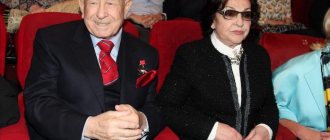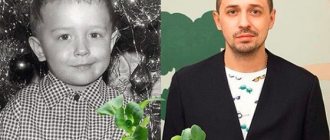Biography
Oleg Popov is a Soviet clown, a student of the legendary Pencil, who during his career managed to conquer the international arena. Queen Elizabeth II of England herself applauded him; streets named after him appeared in Munich and Brussels. In the Guinness Book of Records he is listed as the most popular clown on the planet. In addition, he has several films to his credit. The artist starred in the films “The Adventures of the Yellow Suitcase”, “Mom”, “Blue Bird” and others.
Childhood and youth
Oleg Konstantinovich Popov was born on the last day of July 1930 in the village of Vyrubovo, Kuntsevo district, Moscow region, which currently belongs to the urban settlement of Odintsovo. Soon his parents were given an apartment in the capital, not far from the Dynamo stadium. Oleg Popov's father worked at a watch factory. At the end of the 30s, he was arrested and went to prison, and his mother married another man and changed her last name.
Oleg Popov in his youth / Wikipedia
Oleg's family barely made ends meet, so the boy went to work early. During his first years, he sold soap at the market, which was illegally brewed by his neighbor. As a 12-year-old teenager, Popov got a job at the printing plant of the Pravda newspaper as an assistant mechanic. During the war, people had to starve, and Oleg did not have enough to eat. One day the boy became so weak that he almost died; his mother could hardly leave her son. After this incident, it was decided to send the teenager to the sports section.
Oleg Popov without makeup (still from the film “Clubfooted Friend”)
This is how Oleg Popov got into the acrobatics club at the Wings of the Soviets Sports Palace. During classes, it became clear that many things were easier for the boy than for others. Once upon a time, the head of a circus school drew the attention of a flexible and resilient guy, inviting him to take the entrance exams. A compelling argument in favor of choosing an educational institution were bread cards: college students were entitled to 100 g of bread more than a factory worker.
In 1944, Popov went to study at the State School of Circus Arts. The future artist graduated from this educational institution after 5 years, his specialty was “eccentric on a wire.” During his studies, the artist mastered various circus techniques, which he later used when performing in the arena: juggling, elements of acrobatics and balancing act.
The beginning of a circus career
In 1944, Oleg Popov began practicing acrobatics in a sports club at the Pravda newspaper.
During one of his performances, he was noticed by the head of the State School of Circus Arts. A little later, it was there that the future artist entered. All this was done in secret from his mother, whom Oleg Konstantinovich did not want to upset by saying goodbye to his career in Pravda. Studying at the circus was easy for Oleg: he happily juggled, danced, and practiced on the trapeze and rope. The young man was excellent at acting with facial expressions and even playing music. Popov devoted 10 hours to training every day. And only when it became clear that the circus was the young man’s calling, he confessed everything to his mother. Popov’s mentor helped a lot, convincing the woman that her son would certainly earn his bread and butter.
Young Oleg Popov
In 1946, Oleg Popov, together with his friends from school, began participating in cultural evenings for a fee - coupons for bread, meat, fruits and vegetables. In the hungry post-war times, such help came in handy.
In 1950, Oleg Popov had already amused hundreds of people by entering a permanent job at the Saratov Circus. At first, he acted as a tightrope walker, shocking visitors with dangerous, breathtaking performances under the dome, but just a year later, under the leadership of the clown Pencil, who included the talented young man in his team, he debuted as a carpet clown, entertaining guests between performances. During this period, he acquired attributes that he never parted with on stage - a shaggy, bright lemon mop of hair, wide trousers and a checkered cap.
At the beginning of his circus career, Popov was a carpet clown
And it was from Karandash that Popov learned independent art, in particular, making props for performances himself and thinking through numbers.
Circus
In his youth, after graduating from circus school, Oleg Popov was assigned to the Tbilisi Circus. There he began his career as an artist as a tightrope walker-comedian, and after 2 months he returned to Moscow. Until 1953, he assisted the famous master of the comic genre Karandash at the circus on Tsvetnoy Boulevard. The place of the master’s assistant had previously been occupied by Yuri Nikulin, but after a conflict with the director, the star of “Prisoner of the Caucasus” had to release him.
Clown Oleg Popov (still from the film “The Highest”)
In 1954, a fateful incident occurred in the artist’s creative biography. Popov had to replace Pavel Borovikov, a circus colleague who broke a rib on the eve of the performance. The young clown improvised, imitating a juggler, manipulating forks, spoons and frying pans. The success was stunning, and after this act his role as a carpet clown was finally formed, who was recognized by his bright striped pants and original headdress - a checkered cap.
Since the mid-1950s, Oleg Popov actively toured abroad and directed circus performances. After performing in Great Britain in 1968, he acquired the nickname Sunny Clown. In the 1970s he worked at the Great Moscow State Circus on Vernadsky Boulevard. His most successful and audience-favorite reprises were “Cook”, “Sleep on a Wire”, “Drowned Man”, “Whistle”, “Ray”.
Oleg Popov - “Cook”
Cooperation with the circus on Tsvetnoy Boulevard did not work out. Yuri Nikulin, being its director, for unknown reasons did not invite Oleg Popov to the famous arena. After the death of the comedian in 1997, the Sunny Clown, in a conversation with reporters, expressed bewilderment at the fact that Maxim Nikulin, who had not previously participated in circus life, became the head of the creative team.
In the early 1990s, the artist, dejected by the lack of prospects and low income, immigrated to Germany, while retaining Russian citizenship. After the move, he did not leave his career. In the city of Eglofstein, Popov began working as a clown under the stage name Happy Hans.
Clown Oleg Popov / Patrick Glanz, Wikipedia
The actor's talent manifested itself not only in the performing arts. Oleg Konstantinovich became interested in music. Since the late 90s, Popov has recorded several comic works: “Song about the Circus”, “Song about Repairs”, “Open Your Eyes”. The musical compositions were included in the author's collection of children's songs.
In June 2020, after more than two decades living abroad, the famous Oleg Popov visited his homeland. He delighted with his performance the audience gathered at the Sochi circus for the International Professional Circus Award “Master”. The talent of the Sunny Clown was awarded in the “Circus Legend” category. As Popov later recalled, in Russia a crowd of fans was already waiting for him at the airport, something the artist never expected to see. Fans of the great comedian's work recognized him even without makeup and a wig.
Fateful incident
In 1954, an incident occurred that, without exaggeration, changed the artist’s fate.
When he was on tour in Saratov, local carpet clown Pavel Borovikov broke a rib, and Oleg was asked to perform instead. Popov began to improvise, parodying a juggler. The public received the new circus performer with delight. This moment became the birth of a new circus star. Fame came to 24-year-old Oleg Popov, and his status as a first-class circus clown was firmly established. The artist’s numbers were comical, without a bit of anger or aggression. One of Oleg Popov’s most famous performances is “A Ray of the Sun.” In the mid-50s, Oleg Popov was sent abroad as part of the State Circus. Under the watchful supervision of KGB officers, the performances took place in Monte Carlo. Brussels, Munich. Berlin and Frankfurt. While traveling abroad, Oleg Popov was appointed the main clown instead of Karandash, who abused alcohol. The European press began to enthusiastically write about the artist’s charisma, and upon his return to Moscow, Popov received the title of Honored Artist of the RSFSR. Oleg Popov continued to perform abroad, and in 1959 he experienced incredible success in Australia and Japan. Performances with his participation brought the impresario mountains of gold, but Popov himself and his colleagues received only “pocket” money.
Behind the scenes of the circus
In 1960, Oleg Popov met his idol Charlie Chaplin. The Soviet circus performer was on tour in Italy and learned that the actor was nearby. Charlie, having heard a lot about his Russian colleague, immediately responded to the offer to meet. Despite the language barrier, the comedians found a common language.
In the early 70s, the whole country saw Oleg Popov’s numbers after they were included on the air of the Sunday program “Alarm Clock” - Soviet children were simply delighted.
Oleg Popov in “Alarm Clock” In 1981, in Monte Carlo, Popov was awarded the circus equivalent of the “Oscar” - the “Golden Clown” award. The circus performer received it personally from the hands of Princess Grazia Patricia of Monaco.
Oleg Popov without makeup
During the period of perestroika and the subsequent collapse of the Soviet Union, circus performers had a hard time. The population was busy with more pressing problems; the capital's state circus stood half empty. It is not surprising that Popov began to increasingly think about the end of his career. This, as well as meager pensions and a half-starved existence, forced him to move to Germany, where he began performing under the pseudonym Happy Hans.
Movies
When fame came to Oleg Popov, he began appearing in television programs. In addition, the artist played in more than 10 films. The success of the young clown was so great that his circus act was included in the documentary “Arena of the Brave” (1953). This work became his film debut.
Oleg Popov and Lyudmila Gurchenko (still from the film “Mama”)
The most famous films with his participation were “Clubfooted Friend” (1959), “The Last Crook” (1966), “The Adventures of the Yellow Suitcase” (1970), “Carnival” (1972), “Mom”, “Blue Bird” (1976) , “Trespassers Allowed to Enter” (1987). Most often, the artist played himself in films, appearing in his famous checkered cap, which was an invariable attribute of his image.
“You tour more, you live longer”
When Oleg Popov suddenly disappeared from the State Circus arena, from Russia, there were many rumors and omissions. “What happened to the “sunny clown”, didn’t they share something with Yuri Nikulin?” And the reason was simple and tragic. Oleg Konstantinovich lost his first wife in the early 90s - she died of cancer. And as he himself recalls, “it was so hard and painful...” Touring in Austria and meeting Gabriella was a gift of fate. A pharmacist by training, Gabi is in love with the circus, loves animals, and there have always been horses, dogs, and ponies in her house. Therefore, she entered the program surprisingly easily and organically. Here in the arena, sad Oleg Popov sits alone on a park bench. A little girl approaches him. They don't say a word, but it's clear that she's asking: what happened? Using the art of pantomime, the clown says: he fell in love with a beauty, but she, having broken his heart, left with a crowd of musicians, and threw the lover’s heart into a trash basket next to the bench. The lights go out, the girl approaches the pulsating heart, takes it, raises it high above her head and, to the music from the Charlie Chaplin film, goes into the darkness.
Nadya Knudsen, AiF: Oleg Konstantinovich, what is your family based on? Who runs the farm?
— The circus brings us closer together. We work together, and the housekeeping is on Gabriella’s fragile shoulders. The life of a circus performer is always on wheels. But you know, the circus doesn’t let a person get rusty. The more you tour, the longer you live. There is even a parable like this. Death has come for the circus performer, knocking on the door. And the neighbors answer: “He’s not here, he’s gone on tour.” “Okay,” says death, “then I’ll take another.” A year passes, and death comes knocking again with a scythe at the circus performer. And again: “He’s not here, he’s on tour,” the neighbors answer. So she left with nothing.
— What is the best circus in the world now?
— Canadian, “Circus of the Sun”, “Cirque du Soleil”. Very powerful, colossal, incredibly talented artists gathered there.
— You became a clown by accident, being a substitute, although you graduated from circus school as a tightrope walker. Where did your famous checkered cap come from?
- Yes, I walked on a wire, then I came to the clownery, I searched for my image for a long time. I also found the cap by accident. I was filming at Mosfilm in 1961, I think, and while rummaging through the props, I came across it, tried it on, and haven’t been filming since then.
Soviet clown, People's Artist of the USSR Oleg Popov. 1980 Photo: RIA Novosti / Vyacheslav Runov
— An immodest question: are you a wealthy person?
- The poor one!
— Do you have any real estate other than a house in Germany?
- No. In Moscow, there was a dacha, an apartment, and two cars. All this happened. Well, here is the house, the one that my wife Gabriella has, a Mercedes car.
- Do you read a lot?
— Well, not as much as in Russia, but I read. It was amazing how many books there were. All the walls from top to bottom, but he didn’t bring anything to Germany. Life started again. Everything is new.
— Have you made friends in the West?
— Yes, there are some among the circus performers. Where I live, I have two or three friends. You see, here it’s not like in Russia. I drank a bottle of vodka and was already a friend for life. It's more complicated here.
Russian clowns Antoshka (Ekaterina Mozhaeva) and Oleg Popov on June 17, 2013 in Leipzig. Photo: www.globallookpress.com
— Do you go to church?
— With friends on Sundays, to the Russian Orthodox Church. And then it’s all back to my house—on Siberian dumplings, I make them myself. You see, a person must believe in something. In God, in goodness. Without faith it is empty. And I’ve had this cross for a long time, after one car accident.
— Do you like to drive a car? What did traffic cops tell you in Russia when they intended to issue a fine?
- Oleg Konstantinovich, this is not a circus for you!
Personal life
For a long time, the artist’s personal life was connected with the name of one woman. In 1950, Oleg Popov got married for the first time. His chosen one was called Alexandra, she was a violinist in a circus orchestra. Popov’s wife gave birth to a girl, Olga, who at the age of 13 decided to follow in her father’s footsteps and subsequently also became a circus high-wire dancer. Now the daughter of the legendary clown lives near Frankfurt. After starting a family and having children, she left her circus career. Oleg Popov has a grandson Evgeniy, a granddaughter Vera and a great-grandson Maximilian.
“Alone with everyone” - Oleg Popov
In 1990, Popov's wife died of cancer. For the last 10 years of her life, she had to struggle with an illness; she no longer accompanied her husband on tour and lived in Moscow. At the time of Alexandra Ilyinichna’s death, Oleg Popov was performing in Hamburg and, as a result of the impresario’s persuasion, did not interrupt his tour to go to say goodbye to his wife.
In 1991, Oleg Popov married for the second time. His wife was Gabriele Lehmann, a German by nationality who is 32 years younger than the clown. They met during a performance of the Russian State Circus. The girl came to the event as a spectator, she did not have enough space and had to watch the performance in the aisle.
View this post on Instagram
A post shared by Kostyukova Elizaveta (@lks210) on Nov 3, 2016 at 11:19am PDT
Oleg Popov in recent years
Speaker Popov noticed a standing girl and brought her a chair. Then Gabi came to thank the artist - their chance acquaintance grew into true love, despite the language barrier. The artist’s wife also entered the arena - she quit her job at the pharmacy and began helping Oleg Konstantinovich at his performances. The couple lived in Germany.
Oleg Konstantinovich devoted his free time to animals. On the site where the artist’s mansion stood, he had ponies, pigeons, dogs and rabbits. He never learned German, but communicated with his wife in Russian.
Oleg Popov died
November 03, 2020:
At the age of 86, the famous solar clown Oleg Popov died in Rostov-on-Don. The cause of death was cardiac arrest.
In Rostov-on-Don, on the night of November 1-2, the legendary circus clown Oleg Popov, who received the title of Solar Clown for his famous act “Ray of the Sun,” passed away.
He was 86 years old.
“Oleg Popov died 20 minutes ago...”, TV presenter Alexander Oleshko said on social networks.
Then the sad news was confirmed by the Russian State Circus. “Oleg Popov died. The general director of the Russian State Circus, Dmitry Ivanov, just called me and told me about this,” said Edgard Zapashny, director of the Great Moscow Circus.
According to preliminary data, the 86-year-old artist suffered cardiac arrest at the hotel. As his friends say, he felt good, walked a lot, nothing foreshadowed trouble.
Dmitry Reznichenko, director of the Rostov State Circus, said: “Everything interested him, he joked, had fun, did not complain about anything, nothing hurt him, nothing bothered him. In the evening, sitting in front of the TV, he passed away, one might say, with a smile.”
On social networks, fans of Oleg Popov write that, despite the understanding that Oleg Konstantinovich had a very respectable age, his death came as a shock to many: “So many losses in recent days... Such great people are leaving... We see them off only with applause. May their memory be blessed. And how good it is that Oleg Popov managed to visit his homeland... Goodbye sunny clown, goodbye to a piece of my childhood!”
Let us recall that the return of the Sunny Clown to Russia lasted for a long quarter of a century - since 1991, retaining Russian citizenship, he lived and worked in Germany under the stage name Happy Hans (German: Hans im Glück).
In February 2020, the Sunny Clown appeared on Russian arenas with legendary reprises: among the best are “Cook”, “Whistle”, “Beam”. He also had a big program called “Let there always be sunshine.”
Oleg Popov gave his last tour in Rostov-on-Don.
Oleg Popov - "Luch"
Oleg Konstantinovich Popov was born on July 31, 1930 in the village of Vyrubovo, Moscow region. Now the village has become part of Odintsovo.
Later, the family moved to Obiralovka, where Oleg’s grandparents lived at that time, and then to Moscow and settled in the area of the Dynamo stadium.
He told about his childhood: “I just said about my father, and my mother worked as a retoucher of transparencies. Due to your age, you cannot know this, but earlier, before the advent of color photographs, in pharmacies it was necessary to paint transparencies in different colors - red, green, blue, etc. You know, my dad was a humorous person and drew well, and when I was 8-9 years old, pictures with Charlie Chaplin began to appear on our movie screens, and if my mother gave me change for ice cream, I ran to watch these films, so I really liked him... every kid in those days (maybe even now) had some kind of nickname, but for example, they teased me simply “Fat”, because I was very plump then.”
My father drank heavily and went to prison in 1941. My mother got married a second time and changed her last name.
In 1943, Oleg became an apprentice mechanic at the Pravda printing plant.
In 1944, while studying in the acrobatics club of the Wings of the Soviets Sports Palace, he met students of the circus school and attended their rehearsals. In the same year, Oleg entered the State School of Circus Arts, from which he graduated in 1950 with a degree in eccentric on wire.
Oleg Popov in his youth
He began his career as a tightrope walker, performing the act “Eccentric on a Free Wire” (director-teacher S. Morozov). In 1951 he made his debut as a carpet clown in the Saratov Circus. He finally established himself in this role in the Youth Circus Group under the leadership of the famous clown Karandash (1951-1953).
Oleg Popov created the artistic image of the “Sunny Clown” - a cheerful guy with a shock of straw hair in deliberately wide striped pants and a checkered cap.
“In 1958, the Soviet circus went on tour to Western Europe for the first time. It was a big trip across three countries: Belgium, France and Great Britain. And we were convinced that the phrase: “In Moscow the weather is clear, but in London it is foggy” is true, since in England the sky was gloomy. And in the very first review it was written that in such foggy weather a clown arrived, who illuminated the arena with the sun, making everyone feel warmer. With the light hand of that reviewer, they now always call me the “Sunny Clown,” he recalled.
In his performances he uses such techniques as tightrope walking, acrobatics, juggling, parodying circus acts, but the main place in his performances is occupied by entres, solved by means of buffoonery and eccentricities.
Among the best reprises of Oleg Popov are “Cook”, “Whistle”, “Beam”.
Participant in many television programs, in particular, he took part in the children's television program “Alarm Clock”. He often acted in films, most often in cameos, and acted as a director of circus performances.
The artist took part in the first tours of the Soviet circus in Western Europe. These trips brought him worldwide fame.
Lived in Moscow on Molodezhnaya Street, house 3. Worked at the Great Moscow State Circus near the Universitet metro station.
He was dejected and repeatedly spoke about the loss of his entire life’s savings in the late 1980s and early 1990s during “perestroika” and the collapse of the USSR, about the mockingly small pension that he would have been entitled to, and about his reluctance to earn the missing money by throwing balls in the underground passage .
Since 1991, having retained Russian citizenship, he lived and worked in Eglofstein, Germany under the stage name “Happy Hans” (German: Hans im Glück).
In 1994 he received the Order of Friendship of Peoples as a State Artist.
In June 2020, for the first time after 24 years of living in Germany, I visited Russia. On June 30 he performed at the Sochi circus with two reprises as part of the International Professional Circus Award “Master”.
“I've always gone against the grain. All my reprises are an experiment. By the way, many are taken from life... The reprise with the saxophone was born out of my failure... In my youth, I literally raved about this instrument - large, shiny, elegant. As a college graduate, I couldn’t afford such a thing. But one day I got lucky: in a second-hand store I came across an old saxophone from a very good Selmer company. I was incredibly happy. And imagine my disappointment when it turned out that the instrument was hopelessly damaged. But don't throw it away! And I came up with a reprise: I sawed off the mouthpiece of the saxophone, put a carrot in its place and played the instrument, biting off the mouthpiece in a fit of inspiration,” said Oleg Popov.
Awarded numerous circus awards. Laureate of the International Circus Festival in Warsaw (two gold medals as a clown in the arena and as an eccentric performing on a free wire, 1957). Special prize - “White Elephant” (Belgium, as the best circus artist of the year). Honorary prize "Golden Clown" (French Clown d'or) of the International Circus Festival in Monte Carlo (1981). “Circus Legend” Award (2015).
A circus in Samara bears the name of Oleg Popov.
In December 2020, he performed in St. Petersburg at the opening after the restoration of the Cinizelli Circus.
60 performances were planned for 2020 in St. Petersburg.
Oleg Popov died on November 2, 2020, at the age of 87, in Rostov-on-Don, where he was on tour.
“When they ask me: “Where is your homeland?”, I always answer: “Where the circus is, there is my homeland!” said Oleg Popov.
“First of all, you need to have a great sense of humor in order to immediately see not only good but also bad qualities in a person, and then portray all this in an exaggerated form,” noted the Sunny Clown.
Oleg Popov in the “Tonight” program
Oleg Popov's height: 170 centimeters
Personal life of Oleg Popov:
The first wife since 1950 - Alexandra Ilyinichna (1932-1990), violinist, then circus performer, died of cancer.
The daughter from her first marriage is Olga, a circus dancer on a wire. She performed with her father, however, having started a family, she left the circus and lives near Frankfurt am Main. Oleg Popov is survived by his grandson Evgeniy, granddaughter Vera and great-grandson Maximilian.
Oleg Popov with his first wife Alexandra and daughter
Oleg Popov with his daughter Olga
Since 1991, Oleg Popov was married to German circus artist Gabriela Lerner, with whom he lived in Germany.
Oleg Popov said: “It so happened that my wife died of cancer. Here, without me, in Moscow. So I was alone for a whole year, then I met a girl. The circus is sold out, she stands in the aisle alone. And I tell my friends, listen, bring her a chair, what’s she worth? They brought a chair. She sat down, watched the program, and asked for an autograph. I gave her an autograph... I don’t know what pulled me, the devil or the angel. I’ve never asked for it in my life, but now I asked for a phone number. She gave it, I wrote it down on some newspaper.
And then this incident happened when an impresario ran away from Argentina. I'm calling this girl through an interpreter. I say, here is the situation again. She says: sit, now I’ll come by car, and we’ll sort it out there. In general, she came, took all my things and brought them to her place. That’s how she became my wife.”
Oleg Popov and Gabriela Lerner
Filmography of Oleg Popov:
1953 - Arena of the Brave 1959 - Clubfoot Friend 1966 - The Last Crook - Clown Oleg Popov (cameo) 1967 - The Tallest - Clown Oleg Popov (cameo) 1969 - Kidnapping - Clown Oleg Popov (cameo) 1970 - Two Smiles 1970 - Half an Hour for Miracles - Uncle Painter 1970 - The Adventures of the Yellow Suitcase - Clown Oleg Popov (cameo) 1972 - Carnival - Clown 1976 - A Merry Dream, or Laughter and Tears - Magician Univer 1976 - Mom - Bear 1976 - Blue Bird - Clown 1979 - The Sun in a String Bag - Clown Oleg Popov (cameo) 1986 - Unauthorized entry allowed - clown Oleg Popov (cameo)
Death
On November 2, 2020, Oleg Popov died of cardiac arrest. The death of the 86-year-old legendary clown occurred in Rostov-on-Don. He came there with a new program “Let There Always Be Sunshine” as part of an all-Russian tour.
Monument to Oleg Popov in Rostov-on-Don / Lipunov G.A., Wikipedia
The next day, a funeral service took place in the Church of John of Kronstadt in Rostov-on-Don and a civil funeral service in the city circus. The master's grave is located in the German city of Eglofstein. Instead of the usual monument with a photo, there is a monument with a sculpture of Oleg Popov looking out from behind the curtain.










